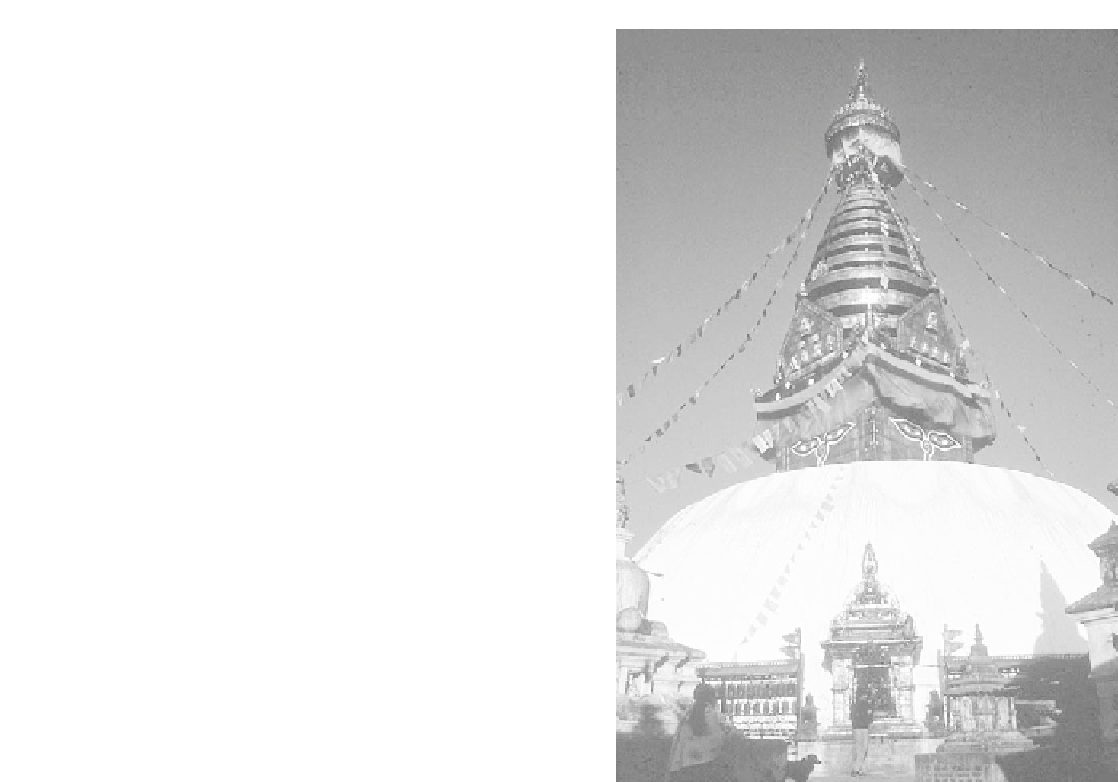Geography Reference
In-Depth Information
endogamy
. This practice of marriage within the
jati
en-
sures continuity of its principles and practices. Caste and
jati
are at once divisive and unifying. While fragmenting
society at large, they provide structured mutual exchange
and support systems at communal levels.
Within a growing mercantile class, the
varnas
had to
be further modified. Commercial dealers were taken into
the
vaishya
class and farmers were demoted to the
sudra
class. Serfs and other low-order
sudras
became casteless
(i.e., outcasts whose designation ultimately hardened
into
untouchables
). Much later in the twentieth century ,
the great Indian leader Mohandas (Mahatma) Gandhi de-
cried the inequities of the caste system and said that the
so-called “untouchables” should be called
harijans
meaning “Children of God.” T Today, , many untouchables
prefer the term
dalits
, meaning the “oppressed.”
After the establishment of Aryan supremacy in the
Indus region and across the northern plains, an Indo-
Aryan culture emerged. Large numbers of Dravidians
were driven southward across the Deccan. There, they
developed a very distinct civilization with their own lan-
guages. In fact, Dravidian languages are fundamentally
different from Indo-Aryan languages. This difference has
induced linguistic strife even into the twentieth century .
BUDDHA AND MAHA VIRA
T Two major religious events occurred in the fourth and
fifth centuries BC. First,
Buddha,
born Siddartha Gau-
tama in the Himalayan foothills of what is now Nepal,
preached the paths and precepts of Buddhism across
northern India. Buddha' s “Middle Way” was appealing as
it lay between the extremes of worldliness and asceti-
cism. He founded
sanghas
(communities for monks) and
viharas
(wet-season refuges). Buddha himself was not
worshipped for another hundred years, and the first
sculptures of him did not appear until the Christian era.
At first, his followers carved simple cells and halls
out of mountain faces, and Indian stone carvers ulti-
mately excelled in their craft. Many carvings and wall
paintings still survive in the wake of Buddhism' s diffu-
sion throughout Asia. Later, lands were provided for
monasteries, and a monastic code was devised. This code
and the Buddhist scriptures were recorded in a script
called
Pali
. Even today , ancient
Pali
prayer scrolls can be
seen in Buddhist monasteries. After his death in 483 BC,
Buddha' s relics were distributed and encased in struc-
tures called
stupas
(Figure 6-5).
The second event was the founding of
Jainism
by
Mahavira
. Both Buddha and Mahavira were
kshatriyas
,
Figure 6-5
This impressive stupa is Swayambunath in Kathmandu, Nepal.
Sacred relics are confined inside the stupa, from which the eyes of
Buddha see all things. Devotees move around the stupa in a clock-
wise direction, chanting and twirling their prayer wheels on the
way .
Photograph courtesy of B. A. Weightman.
both disdained social class distinctions, and both ad-
dressed the fears of never-ending rebirths. Mahavira was
from the region of Bihar. He became a wandering ascetic
at the age of 30. He preached in the Ganges valley until
he died around 612 BC. In Jainism, the Buddhist injunc-
tion against killing became all inclusive: people, animals,
insects, and even certain plants. Jainism was nonmateri-
alistic, but since at first it was only property holding that
was forbidden, the religion became popular with the
mercantile class. Cultivators and soldiers obviously
failed to meet the nonviolence standards. Concentrated
mainly in the state of Gujarat, Jains have managed to re-
tain an unbroken tradition in India.

















Search WWH ::

Custom Search